Mon 18 Feb 2008
BRUNO FISCHER – The Girl Between.
Gold Medal 1054. Paperback original; 1st printing, 1960.
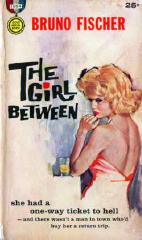
Here’s a pulp story that’s designed to tell you what really goes on inside the traditional smoke-filled room of small-time politics. To get onto the best-seller list, you have to aim a little higher, on the congressional level, at the very least, but [the] politics are dirtier, and the politicians even less further removed from racket bosses, in the realm of town and state government.
Or so says Bruno Fischer, in this story of just such a [local] political boss. The father of his right-hand man, [leading protagonist] Curt Stone was a good guy squeezed out a long time ago. Two members of the opposition end up murdered, and one of their wives would make a handy scapegoat, if only she could be located. Other essential members of the cast are Maryann, the big man’s wife, who still feels the need to play around, and Hank, the throwback to another era, when brawn rather than brains was the more important requirement.
Erle Stanley Gardner could have written parts of it. With calm, cool uncomplicated prose Fischer lets Stone dig himself in deeper and deeper, until he’s forced to choose sides once again. The reader is expected to pick up on an occasionally subtle plot twist, but you shouldn’t expect Fischer to reveal the killer quite so easily. The ending is pretty corny, and you probably even know what it is by now. Otherwise, I liked it fine. [B minus]
[UPDATE] 02-18-08. I liked to be elusive back when I wrote this, didn’t I? Or do I mean allusive? I added a couple of inserts and corrected one misspelled word, but it didn’t help. I have no idea what the ending is, except that I assume it turned out well, and a little soapy. Or do I mean soupy? No, I don’t think so.
Here’s a complete list of Bruno Fischer’s work for Gold Medal. The Girl Between was the last book he wrote until The Evil Days in 1974, about which more later. Any of these is going to be worth reading. I guarantee it.
House of Flesh. Gold Medal 123, 1950.
The Lady Kills. Gold Medal 148, 1951.
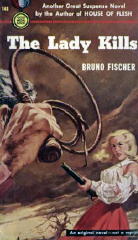
Fools Walk In. Gold Medal 209, 1951.
The Fast Buck. Gold Medal 270, November 1952.
Run for Your Life. Gold Medal 343, October 1953.
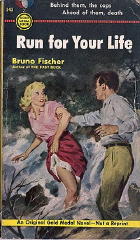
So Wicked My Love. Gold Medal 437, October 1954.
Knee-Deep in Death. Gold Medal 591, July 1956.
Murder in the Raw. Gold Medal 694, August 1957.
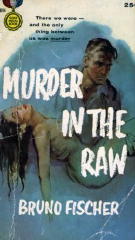
The Lustful Ape. Gold Medal 901, July 1959; previously published as by Russell Gray (Lion 38, August 1950)
Second-Hand Nude. Gold Medal 928, October 1959.
The Girl Between. Gold Medal 1054, November 1960.
I’ll set up a link as well, but here below is Fischer’s mini-biography, as Victor Berch, Bill Pronzini and I wrote it in connection with the three books he wrote for Ziff Davis’s line of Fingerprint Mysteries. (In keeping with the covers I’ve already used, however, I’ll use scans of various paperback editions instead of the hardcovers. I hope you don’t mind.)
The Pigskin Bag, 1946
More Deaths Than One, 1947 [ PI Ben Helm]
The Bleeding Scissors, 1948
Before turning to writing for the pulp magazines in 1936, Bruno Fischer, born in Germany in 1908, held a variety of other jobs after high school: he was a sports reporter, rewrite man and police reporter for a Long Island newspaper, he was a truck driver and chauffeur, and he did book reviews and political columns for New Republic and other similar magazines. (The entire Fischer family emigrated to the US in 1913.)
Once established in the pulp field, however, Fischer became a full-time writer, producing hundreds of mystery, detective, and weird menace stories for just about every magazine under the sun, using both his own name and the pseudonymous Russell Gray.
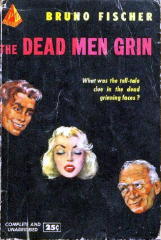
Fischer’s first hardcover mystery novel, So Much Blood, was published by Greystone Press in 1939. His primary series character, medium-boiled private eye Ben Helm, first appeared in The Dead Men Grin (McKay, 1945). Helm, who was married and was perhaps as much a criminologist as he was a PI, ended up in a total of six mystery adventures in hardcover before he was through.
Fischer left the pulps and hardcover fiction behind in the early 1950s, and much of his reputation among collectors today rests on the large number of original crime novels he began doing then for Gold Medal. After 1969 he gave up writing to assume the positions of executive editor of Macmillan’s Collier Books and education editor of the Arco Publishing Company, both of which he held for over a decade.
As for Fischer’s books in the Fingerprint series, The Pigskin Bag is a finely crafted suspense novel about a man who finds the eponymous bag in his garage, it having belonged to a man who died in an accident witnessed by his wife. Before he can take the bag to the police, it is stolen and a murdered man left in its place in the garage. Reviews were uniformly excellent. Will Cuppy in the Saturday Review, for example, called it “exciting, fast-moving, with some spine-tingling moments.”
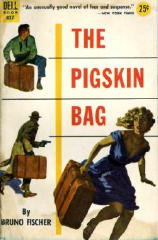
The Bleeding Scissors is another suspense novel, this one involving a man whose wife suddenly and inexplicably turns up missing, a New York City play called “The Virgin Mistress,” an apparent hit-and-run death, and a villainous private detective (not “Nameless”).
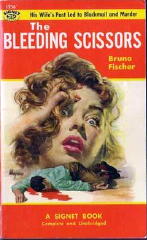
More Deaths Than One, the middle entry among Fischer’s Ziff-Davis mysteries, is Bill’s own favorite among the three. This one is an unusual detective story told in alternating first-person viewpoints among six principal characters, one of whom is Ben Helm, and another one of whom is the cleverly and fairly concealed murderer of a womanizing artist in a small upstate New York town.
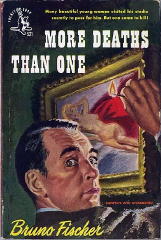
Fischer was particularly good at drawing believable characters whose actions and motivations are psychologically sound, an ability he demonstrated to good advantage in More Deaths Than One, and equally so in The Evil Days, his final work of crime fiction (Random House, 1974). Failing eyesight regrettably prevented Fischer from doing others, as he had planned. He died in 1992.